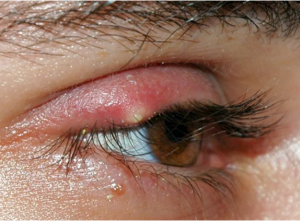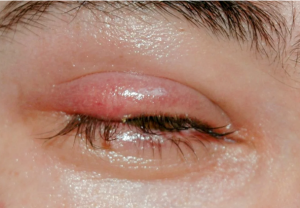Stye is a very common and frequent eye condition that can cause discomfort and concern, but with the right information it can be managed effectively. This disorder manifests itself as a small, painful swelling on the eyelid, often caused by a bacterial infection or obstruction of the sebaceous glands. Understanding the main causes and associated risk factors can help prevent its onset and reduce discomfort. In this guide, we look at the origins of stye, offering practical tips for avoiding it and treating it effectively when it occurs. Let's find out together how to keep our eyes healthy and free from discomfort.
What is stye
Stye is a benign inflammation of the eyelids, which is one of the most common eye conditions.
It is important to understand what it is in order to deal with it in the best possible way. In this section, we will explore the aetiology of stye, the characteristic symptoms and the different types that can occur.
Definition and Symptoms
Stye appears as a small painful swelling on the eyelid, often caused by a bacterial infection.
This swelling is due to inflammation of the sebaceous or sweat glands located near the base of the eyelashes.
Some of the most common symptoms that can occur include:
- Pain and redness in the affected area
- Foreign body sensation in the eye
- Excessive tearing
The swelling is usually well delimited and may contain pus.
It is of paramount importance to recognise these symptoms in order to intervene at an early stage.
Types of stye
There are mainly two types of stye: outside e inside.
The outer one develops on the outside of the eyelid, while the inner one forms on the inside of the eyelid itself.
- Outer stye: It affects the sebaceous glands at the base of the eyelashes. It is more visible and often less

External stye painful.
- Internal styeIt involves the Meibomian glands, being more painful and less noticeable.
Understanding the difference between these types helps determine the most appropriate treatment.
Main Causes of Stye
Identifying the causes of stye is essential to prevent its occurrence. We will look at both environmental factors and genetic predispositions that may contribute to this condition.
Environmental Factors and Habits
Environment and personal habits play a crucial role in the development of stye.

Exposure to dust, wind and pollution can increase the risk of eye infections.
The use of expired or inadequately removed cosmetics can also contribute.
- Dirty handsTouching the eyes without first washing your hands can transfer bacteria to the periocular area and promote the onset of stye.
- Use of contact lenses: Inadequately cleaned, poorly maintained or expired lenses can cause irritation to the surface of the eye and the periocular area.
Adopting good hygiene practices is crucial for prevention.
Arrangements
Some individuals are more predisposed to developing stye, due to their genetic make-up. In fact, if there is a frequent history of stye in the family, the risk increases.
Medical conditions such as seborrhoeic dermatitis and acne rosacea can also influence the frequency of styeing.
So we can summarise among the predisposing conditions:
- InheritanceAn important factor to consider.
- Pre-existing dermatological conditionsThey may increase susceptibility to infection.
Being aware of these predispositions makes it possible to take more targeted preventive measures.
Recognising Signals
Stye symptoms may vary in intensity, but some signs are common.
Typically, the first symptom is a small, red, painful swelling on the eyelid.
Other symptoms include:
- Itching or burning sensation.
- Excessive tearing.
- Sensitivity to light.
Recognising these symptoms early allows measures to be taken to alleviate discomfort and speed up healing.
When to Worry
While styes are generally harmless, there are situations in which one should be concerned.
A stye that does not improve within a week may indicate a more serious infection.
Warning signals include:
- Increased pain and swelling.
- Fever or chills.
- Blurred vision.
In such cases, it is essential to consult an ophthalmologist in good time to assess the appropriate treatment.
Prevention Methods
Preventing stye is possible with a few simple measures. We will examine the importance of personal hygiene and how a healthy lifestyle can contribute to ocular health.
Personal Hygiene and Care
Proper personal hygiene is the first line of defence against stye.
- Wash hands frequently.
- Avoid touching eyes with dirty hands.
- Remove make-up thoroughly before going to sleep.
These simple actions significantly reduce the risk of infection.
Nutrition and Lifestyle
A healthy lifestyle supports eye health.
A balanced diet rich in vitamins can strengthen the immune system and reduce the incidence of eye infections.
- Vitamin AVitamin A, or retinol, is a fat-soluble vitamin essential for vision, growth and normal tissue development, as well as contributing to the functioning of the immune system. It is mainly found in foods of animal origin, but also in milk and its derivatives (butter and cheese) and eggs. In contrast, carotenoids, the precursors of vitamin A, are found in many foods of plant origin. Carotenoids are particularly present in red, yellow and orange fruits and vegetables, such as apricots, carrots, watermelon, berries and tomatoes.
- Omega-3Omega-3s are essential polyunsaturated fatty acids, i.e. they must be taken in with food because the body does not produce them. They are important for heart health, brain health and in general for the prevention of many diseases. Omega-3s are mainly contained in fish, nuts, such as walnuts and hazelnuts, but especially in certain oils (mainly in linseed and flaxseed oil)
Incorporating these nutrients into the daily diet can make all the difference in prevention.
Natural Remedies and Treatments
When a stye occurs, it is important to know how to treat it effectively. This section explores the remedies that can be adopted in the home environment and examines the situations in which it is necessary to consult a doctor.
Home Treatments
Home treatments can be effective in mild cases of stye.
They are often recommended hot packsto be practised in this manner:
- Apply a warm cloth to the closed eye for 10-15 minutes, three times a day.
- Gently massage the eyelid to promote drainage.
These simple remedies can alleviate pain and accelerate healing.
When to Consult a Doctor
Although many styes can be treated at home and resolve spontaneously, there are situations in which it is essential to consult a professional.
If symptoms persist for more than a week or if complications occur, it is advisable to consult a doctor.
In particular, in cases of intense pain or worsening of symptoms, it is essential to seek medical assistance.
A doctor can determine whether more specific treatments are needed, such as:
- Antibiotics: In cases of persistent or severe infections.
- Incision and drainage: In rare cases, minor surgery must be performed by a specialist.
Subsequent treatment varies depending on symptoms and response to initial treatment.
Myths and Truths about the Stye
There are many myths about stye that can be confusing. In this section, we will dispel some of the most common false myths and provide reliable scientific truths.
Common False Myths
Many people believe that stye is contagious, but it is not.
Others think that squeezing a stye may help, but in reality it can make the infection worse.
- Not contagious: Stye results from local bacterial infections.
- Do not squeeze: Can cause further infections.
Knowing the truth helps to manage the situation better.
Scientific Truths and Reliable Advice
Scientific truths about stye can guide preventive actions and treatments. It is important to follow evidence-based medical advice:
- Hygiene is fundamentalWashing hands is the best prevention.
- Consult a doctorEssential if symptoms persist.
Following these tips can reduce the incidence and severity of styeing.
On the subject of infections of the ocular adnexa see also:
- Chalazion: causes and remedies - Oculista Italiano
- Eyelid dermatitis: how to prevent it - Oculista Italiano
- Ocular manifestations of dermatological diseases: infectious and inflammatory disorders - Oculista Italiano
- Willmann D, Guier CP, Patel BC, Melanson SW. Hordeolum (Stye). 2024 Dec 11. In: StatPearls [Internet]. Treasure Island (FL): StatPearls Publishing; 2025 Jan-. PMID: 29083787.
- Carlisle RT, Digiovanni J. Differential Diagnosis of the Swollen Red Eyelid. Am Fam Physician. 2015 Jul 15;92(2):106-12. PMID: 26176369.
